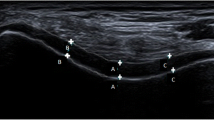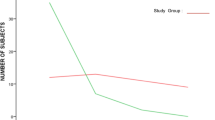Abstract
The cartilage oligomeric matrix protein (COMP) is a glycoprotein, which occurs mainly in an articular cartilage. The amount of this protein increases under the influence of cytokines and growth factors. As a result of various diseases that cause damage to cartilage, fragments of matrix protein are released into synovial fluid and then into blood. The assessment of matrix protein level in serum, for example COMP, permits the establishment of the degree of cartilage damage in inflammatory joint diseases, and permits observation of the effectiveness of the treatment. Blood was collected from 30 systemic lupus erythematosus (SLE) patients, and from 30 patients with knee osteoarthritis (OA) who constituted the control group. Serum COMP level was determined using an inhibition enzyme-linked immunosorbent assay (ELISA). The average value of the serum COMP level in SLE patients was 11.3±3.7 U/l. According to correlation coefficients, serum COMP level is independent of patients’ age, disease duration and the clinical picture of SLE. No correlation was found between serum COMP level and bone mass density (BMD) changes. In SLE patients with decreased haemoglobin levels (<11.0 g/dl) values compared with patients with normal haemoglobin level, the serum COMP level was observed to be significantly higher (P<0.05). Both in SLE patients with erythrocyte sedimentation rate (ESR) values over 60 mm/h and in patients with ESR values below 60 mm/h, the serum COMP level was observed to be significantly higher (P<0.05). A significant positive correlation was found between serum COMP level and ESR value, as well as a number of thrombocytes. Negative correlation occurred between the serum COMP level and the value of haemoglobin. The average value of COMP in OA patients was 10.4±2.7 U/l. No correlation was found between serum COMP level and patients’ age and disease duration. There was correlation between the serum COMP level and the T-score value of densitometry examinations in OA patients. No statistical differences were found between the average serum COMP levels for SLE and OA patients.



Similar content being viewed by others
References
Saxne T, Heinegard D (1992)Cartilage oligomeric matrix protein: a novel marker of cartilage turnover detectable in synovial fluid and blood. Br J Rheumatol 31:583–591
Morgelin M. Heinegard D, Engel J, Paulsson M (1992) Electron microscopy of native cartilage oligomeric matrix protein purified from the swam rat chondrosarcoma reveals a five-armed structure. J Biol Chem 267:6137–6141
Hedbom E, Antonsson P, Hjerpe A, Aeschlimann D, Paulsson M, Rosa-Pimentel E, Sommarin Y, Wendel M, Oldberg A, Heinegard D (1992) Cartilage matrix proteins: an acidic oligomeric protein (COMP) detected only in cartilage. J Biol Chem 267:6132–6136
Franzen A, Heinegard D, Solursh M (1997) Evidence for sequential appearance of cartilage matrix proteins in developing mouse limbs and in cultures of mouse mesenchymal cells. Differentiation 36:199–210
DiCesare P, Morgelin M, Mann K, Paulsson M (1994) Cartilage oligomeric matrix protein and trombospondin. Purification from articular cartilage, electron microscopic structure, and chondrocyte binding. Eur J Biochem 223:927–937
Neihart M, Hauser N, Paulsson M, Dicesare PE, Michel BA, Hauselmann HJ (1997) Small fragments of cartilage oligomeric matrix protein in synovial fluid and serum as markers for cartilage degradation. Br J Rheumatol 36:1151–1160
Wollheim FA, Eberhardt KB, Johnson U, Saxne T (1997) HLA DRB1* typing and cartilage oligometric matrix protein (COMP) as predictors of joint destruction in recent-onset rheumatoid arthritis. Br J Rheumatol 36:847–849
Mansson B, Carey D, Alini M, Ionescu M, Rosenberg LC, Poole AR, Heinegard D, Saxne T (1995) Cartilage and metabolism in rheumatoid arthritis. J Clin Invest 95:1071–1077
Forslind K, Eberhardt K, Jonsson A, Saxne T (1992) Increased serum concentrations of cartilage oligomeric matrix protein. A prognostic marker in early rheumatoid arthritis. Br J Rheumatol 31:593–598
Lindquist EK, Saxne T, Eberhard K (2002) Relationship between functional capacity, disease activity, pain and joint destruction during the first 10 years of rheumatoid arthritis. Ann Rheum Dis 61(suppl 1):74
Fex E, Eberhardt K, Saxne T (1997) Tissue-derived macromolecules and markers of inflammation in serum in early rheumatoid arthritis: relationship to development of joint destruction in hands and feet. Br J Rheumatol 36: 161–166
Peterson IF, Boegard T, Dahlstrom J, Svensson B, Heinegard D, Saxne T (1996) Bone scan and serum markers of bone and cartilage in patients with knee pain and osteoarthritis. Osteoarthr Cartilage 6:33–39
Vilim V, Olejarova M, Machacek S, Gatterova J, Kraus VB, Pavelka K (2002) Serum levels of cartilage oligomeric matrix protein (COMP) correlate with radiographic progression of knee osteoarthritis. Osteoarthr Cartilage 10:707–713
Haberhauer GF, Feyertag J, Kittl EM, Bauer K, Dunky A (2002) Steroid treatment normalises the varialibity and levels of serum COMP in RA patients, indicating a possibility to monitor effect of cartilage protective drugs. Rheum Dis 61(suppl 1):200
Haberhauer GF, Feyertag J, Kitti EM, Bauer K, Dunky A (2003) Rapid decrease of COMP serum levels in patients with active RA undergoing IV steroid treatment. Ann Rheum Dis 62(suppl1):166
Crnkic M, Masson B, Larsson L, Geborek P, Heinegard D, Saxne T (2003) Serum Cartilage Oligomeric Matrix Protein (COMP) decreased in rheumatoid arthritis patients treated with infliximab or etanercept. Arthritis Res Ther 5:R181–R185
Den Broeder AA, Jonsten LAB, Saxne T, Heinegard D, Fenner H, Miltenburg AMM, Frasa WLH, van Tils LJ, Buurman WA, van Riel PLCM, van de Putte LBA, Barrera P (2002) Long term anti-tumor necrosis factor alfa monotherapy in rheumatoid arthritis: effect on radiological course and endothelial activation. Ann Rheum Dis 61:311–318
Tan EM, Cohen AS, Fries JF, Masi AT, McShane DJ, Rotthfield NF, Schaller JG, Talal N, Winchester RJ (1982) The 1982 revised criteria for the classification of systemic lupus erythematosus. Arthritis Rheum 25:1271–1277
Hochberg MC (1997) Updating the American College of Rheumatology revised criteria for the classification of systemic lupus erythematosus. Arthritris Rheum 40:1725
Altman R (1991) Classification of disease: osteoarthritis. Semin Arthritis Rheum 21(suppl 2):40–47
Emlen W, O’Neill LO (1997) Clinical significance of antinuclear antibodies. Comparison of detection with immunofluorescence and enzyme-linked immunosorbent assays. Arthritis Rheum 40:1612–1618
Robert R, Sokal F, Rohlf J (1986) Biometry. Freeman, New York, pp 354–359, 691–714
Heinegard D, Oldberg A (1989) Structure and biology of cartilage and bone matrix noncollagenous macromolecules. FASEB J 3:2042–2051
Author information
Authors and Affiliations
Corresponding author
Rights and permissions
About this article
Cite this article
Wisłowska, M., Jabłońska, B. Cartilage oligomeric matrix protein in serum in systemic lupus erythematosus and knee osteoarthritis. Preliminary communication. Rheumatol Int 25, 373–378 (2005). https://doi.org/10.1007/s00296-004-0581-7
Received:
Accepted:
Published:
Issue Date:
DOI: https://doi.org/10.1007/s00296-004-0581-7




